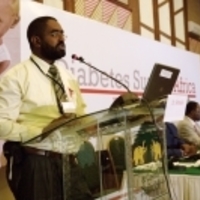Papers by Vanessa R Moodley

Health SA Gesondheid, Mar 22, 2024
Optometry is historically known for conducting urban-based, private practice-oriented clinical tr... more Optometry is historically known for conducting urban-based, private practice-oriented clinical training under the supervision of private optometrists (Ebrahim et al. 2019:1). This strategy may have significantly contributed to the overwhelming majority of graduates directly entering private sector Background: Clinical training, supervision and practice are the most important aspects of health profession education, including optometry. Institutions implore various methods for students to gain access, exposure and experience in different clinical environments, away from their normal academic settings. Aim: This review aimed to investigate studies and related documentary evidence to determine existing standards and methods for educational institutions in conducting optometry clinical training at the external sites. Setting: The electronic databases -ProQuest One, Scopus, EBSCOhost, Sabinet, Science Direct and Google Scholar -were searched systematically for studies on the implementation of workplace clinical training of undergraduate optometry students. The study followed the Joanna Briggs Institute (JBI) systematic review methodology and a systematic search of various electronic databases was conducted for studies on implementation of workplace clinical training. Of the 450 full-text studies searched, 13 studies were found to be reputable sources of evidence and were included in this systematic review. Results: Four themes relating to student clinical training emerged, namely, clinical training approaches implemented, expected minimum standards at the training sites, clinical training environment wherein students and supervisors find themselves and clinical competence of the supervisors and students. They encompass important factors to consider in the planning and provision of quality, efficient and effective student clinical supervision at the external training facilities. There is a dearth of scholarly studies to guide clinical training of optometry training within the public health sector. However, more studies are undertaken in other health disciplines, and they provide generic guidelines, which can be adapted for optometry. The article highlights the need for further studies in optometry student clinical training, focussing on programme designs and standardisation of clinical training in multi-institutional, low-income contexts.

African vision and eye health, May 21, 2024
Background: Adequate knowledge and skills by eyecare personnel and administrators are essential f... more Background: Adequate knowledge and skills by eyecare personnel and administrators are essential for the early diagnosis and prompt management of keratoconus (KC). Aim: This study aimed to determine the knowledge and skills of key stakeholders on KC management in eyecare facilities of Bafoussam, West Region of Cameroon. Setting: Eyecare facilities in the West Region of Cameroon. Methods: A qualitative study, using a purposive (non-probability) sampling technique, was applied to collect data relevant to this study. In-depth interviews were used to collect data from eyecare personnel and administrators. Eyecare personnel in this study comprised optometrists, ophthalmic nurses and optometric technicians, who are trained to World Council of Optometry (WCO) competency level one or two. There were no ophthalmologists working at the study sites. Data obtained were captured, de-identified and stored in a passwordprotected electronic file. Data were coded and analysed applying a deductive thematic analysis approach. Results: There were 21 participants (five administrators and 16 eyecare professionals) from five facilities. Fourteen (66.6%) were males; 10 (47.6%) had 11-20 years of work experience. The majority of the participants had limited or no knowledge of KC. They reported an undersupply of KC diagnostic equipment and consumables at facilities, resulting in poor diagnosis and management of KC patients. Conclusion: The study revealed inadequate knowledge, training and skills of eyecare practitioners and administrators on KC. Deficiencies in KC diagnosis and management could cause visual impairment with a potential negative impact on the quality of life (QoL) of KC patients. Contribution: This study illustrates the need to procure basic equipment, capacitate eyecare workers with knowledge of KC and establish standard clinical protocols for the diagnosis and management of KC, including referral pathways.

Clinical optometry, Feb 1, 2024
Background: Early diagnosis and management of keratoconus (KC) are important for limiting visual ... more Background: Early diagnosis and management of keratoconus (KC) are important for limiting visual complications of the disease. This study aimed to explore the perspectives of optometrists on the barriers to effective diagnosis and management of KC in Kenya. Methods: An online questionnaire was distributed to optometrists in Kenya to collect data on barriers to the diagnosis and management of KC. Results: The majority (60.9%) of optometrists were confident in retinoscopy and subjective refraction. Fewer were confident in the use of keratometers (46.4%) and corneal topographers (24.9%) and in the fitting of rigid gas permeable (RGP) contact lenses (25.0%). The most commonly reported barriers to improving their knowledge and skills were, limited continuous professional development opportunities (87.4%), high costs of conferences (86.1%) and the lack of diagnostic tools (79.5%). Impediments cited to diagnosing and managing KC effectively were a lack of national guidelines (64.9%), patient education material (71.5%), equipment (58.9%) and RGP supply (68.2%) and cost (67.5%). Most commonly reported barriers related to patients were compliance (91.4%), affordability (90.7%), RGP discomfort (89.4%), willingness to pay (88.1%) and the lack of patient education about KC (87.4%). Conclusion: This study showed that the lack of national guidelines, essential equipment and adequate practitioner knowledge and skills were barriers to KC diagnosis and management. Regulation of optometric education and clinical practice, development of national guidelines for diagnosis and management of KC, up-skilling of practitioners and cost-effective solutions for equipment procurement and maintenance may improve both access to, and quality of, care to patients with KC.

Research Square (Research Square), Dec 18, 2023
Background To determine the prevalence and demographic pro le of keratoconus (KC) among high scho... more Background To determine the prevalence and demographic pro le of keratoconus (KC) among high school students in Nairobi County, Kenya. Methods In this population-based, prospective, cross-sectional study, multistage cluster sampling was used to select the participants. All students underwent visual acuity measurement, auto-refraction, retinoscopy and corneal topography. Students with corneal topography patterns suspicious of KC were referred for corneal tomography. Results A total of 3 051 students from 29 schools, with a mean age of 17.4 ± 1.6 years (range: 13-25 years) were screened. The prevalence of KC was 1.7% (n = 51) (95% CI, 1.2-2.2) and of KC suspects was 3.8% (n = 117) (95% CI, 3.2-4.6). There were no signi cant associations between the prevalence of KC and gender, age or ethnicity (all p > 0.05). In the KC group, 88.2% (n = 45) were unaware of their condition, 52.9% (n = 27) were treated for allergic conjunctivitis, 45.1% (n = 23) required spectacles, 11.8% (n = 6) were recommended contact lenses in at least one eye and 49.0% (n = 25) were recommended corneal crosslinking.
African Vision and Eye Health, Apr 17, 2018
Conclusion: Introducing optometrists within the public sector improves access to services for rur... more Conclusion: Introducing optometrists within the public sector improves access to services for rural communities. However, the minimum standard of optometric care is not practised, allegedly because of a lack of equipment. Therefore, resources should be made available to enable optometrists to provide comprehensive optometric services. In addition, the study highlighted the need for more optometry posts in rural communities and for the implementation of career growth paths to attract and retain optometrists within the public sector.

African Vision and Eye Health, Apr 21, 2023
Option to participate (OTP) contracts with a network require participating providers to agree to ... more Option to participate (OTP) contracts with a network require participating providers to agree to predetermined tariff structures, reimbursement at levels that are often discounted below market rates and to conform to certain clinical protocols. Generally, practitioners reluctantly sign participation agreements to be able to receive direct payment and be endorsed to deliver eye care Background: Private healthcare in South Africa is largely financed by medical schemes. Optometrists reluctantly contract with administrators and networks to service these patients, despite them feeling networks are undesirable and exploitative. Networks contend that various mechanisms employed are necessary to ensure sustainability and prevent fraud, wastage and abuse. A working relationship between practitioners and networks should ideally be cordial and appreciated by each party as being mutually beneficial to the success of their respective businesses. Aim: To assess practitioners' knowledge and perceptions regarding optometric networks. Setting: The study was conducted amongst optometric professionals in the private sector in South Africa. Methods: A descriptive, mixed-method study was conducted using a semi-structured questionnaire. Interviews with senior personnel from the networks were conducted. Results: Approximately 77% of respondents belonged to networks with 91% being knowledgeable about networks and their role within optometry. Opticlear had 72% members, while Iso Leso and preferred provider negotiators (PPN) had 67% and 41%, respectively. Most optometrists (69%) neither believed in the need for networks nor that they provide value to the profession, while 94.7% joined networks merely to receive direct payment and access patients, with no other benefits noted. Conclusion: Practitioners reluctantly contract to networks for direct payment and to access patients. Furthermore, practitioners feel that networks bully and victimise them while networks highlight their responsibility to reduce healthcare costs and negative practices of fraud, waste and abuse. Contribution: Providing sustainable, cost-effective and quality eye care services requires collaboration between networks and practitioners and appreciating each other's roles in the delivery of eye care services.

Clinical Optometry, 2020
Introduction: Visual acuity (VA) and refractive error (RE) remain important parameters in the man... more Introduction: Visual acuity (VA) and refractive error (RE) remain important parameters in the management of keratoconic (KC) patients. Despite rapid amelioration in capacity of diagnostic equipment, these remain inaccessible to the majority of practitioners in lowincome countries. Notwithstanding limitations, practitioners are expected to utilize existing resources to satisfactorily manage their increasing numbers of keratoconic patients. Purpose: To determine the changes in visual acuity and refractive errors with diagnostic and management options available in low-income contexts. Methods: A descriptive, retrospective chart analysis of medical records dating back 5 years was employed in this study. Records of patients prescribed with corneal rigid gas permeable (RGP) and scleral lenses were analyzed. Data on age, gender, stage of keratoconus, pre-, and post-visual acuities and refractive errors, mode of correction and lens parameters were evaluated. Results: A total of 124 medical records were analyzed. Males comprised 58.9% and females 41.1% of the total sample, with a mean age 20.86 ± 9.50 years. The mean unaided VA in logMAR notation was 1.0±0.19, while corrected VA was 0.18±0.17. There was a significant improvement (p=0.001) in VA with corneal RGP contact lenses (mean 0.19±0.17) as compared to unaided VA (mean 1.29±0.20). Scleral lens VA also improved from a median of 1.06 to −0.01 logMAR; p=0.001. The mean RE before RGP contact lens fitting was −9.43 ±2.37 diopters (D) which improved to −0.41±0.78D. RE reduced significantly (p=0.001) after fitting with both corneal RGP lenses (from a mean of −9.80±4.46D to −0.45±0.80D) and scleral lenses (from a median of −8.00D to −0.02D). Conclusion: Significantly improved visual acuity and refractive error status were achieved with all KC patients. Despite the diagnostic equipment and contact lenses design limitations, practitioners in low-income contexts can fit the relatively more affordable corneal RGP lenses to positively impact the daily living experiences of their KC patients.

Journal of Public Health in Africa, Dec 21, 2018
Compared to other African countries, Swaziland performs the worst in terms of providing eye healt... more Compared to other African countries, Swaziland performs the worst in terms of providing eye health care services. A priority goal of the World Health Organization (WHO) is to alleviate childhood blindness, particularly in low-income countries such as Swaziland, where many people live in poverty, which is a contributor to poor health outcomes. A mixed method approach that entailed a document review, key informant interviews and clinical facility assessment questionnaires was used. Hospitals and mission clinics offering ophthalmic services were identified through the website of the Ministry of Health and verified during key informant interviews. A saturated sampling procedure was applied due to the few facilities that offer eye care services. Six framework components from the WHO for analysing health systems were utilised in an eye health care service context: leadership and governance, eye health services, eye health workforce, eye health financing systems, eye health medical supplies and technologies, and eye health information systems. Poor management, lack of accountability, poor monitoring and evaluation mechanisms, weak coordination and ineffective private-public sector regulations were identified as factors that lead to poor eye care in the country. The optometrists indicated that refractive services are the most rendered ophthalmic services. The exodus of healthcare practitioners has contributed to the downfall of the public health sector in the country. Five government eye care facilities, 3 government hospitals, 1 non-governmental organization (NGO) and a church mission clinic were included in this analysis. The eye services distribution favors the more affluent areas, particularly the more urban Hhohho Region, which is also where most of the eye health professionals are located. No campaigns have been conducted to prevent childhood blinding diseases or create awareness about getting children's eyes tested for refractive correction. The burden of eye diseases among children in Swaziland remains unknown. More eye health care personnel and equipped facilities are needed throughout the country, and the eye health care program needs to be adopted.

Research Square (Research Square), Oct 26, 2022
Background: To explore current eye care practice in keratoconus diagnosis and management in Kenya... more Background: To explore current eye care practice in keratoconus diagnosis and management in Kenya. Methods: An online questionnaire was distributed to ophthalmic clinical o cers (OCO) and optometrists. Results: A total of 203 responses were received from 52 OCOs and 151 optometrists with a response rate of 24.4% and 53.5% respectively. The majority reported having access to retinoscopes (88.5%; p=0.48) and slit lamps (76.7; p=0.14). Few practitioners did not have access to a corneal topographer (13.5%; p=0.08) and rigid contact lens (CL) tting sets (OCOs 5.8%, optometrists 33.8%; p<0.01). One-third did not feel that retinoscopy (38.7%; p=0.21), slit lamp ndings (30.3%; p=0.10) and corneal topography (36.6%; p= 0.39) are important investigations in keratoconus diagnosis. Corneal topography was not recommended in two-thirds of patients (59.0%; p=0.33) with vernal keratoconjunctivitis (VKC). The majority counselled against eye rubbing in mild (73.6%; p=0.90) VKC, 52.9% in moderate (p=0.40) and 43.6% in severe (p=0.24) cases. The majority prescribed spectacles in mild (90.2%; p=0.95), 29% (p=0.97) in moderate and 1.9% (p=0.05) in severe cases. When the binocular best corrected visual acuity (BCVA) with spectacles was ≤ 6/18, 76.9% of OCOs and 58.9% of optometrists referred for CLs (p=0.02). When binocular BCVA with CLs dropped to ≤6/18, 83.7% (p=0.18) referred to the ophthalmologist for surgical intervention. Few OCOs tted rigid CLs (15.4% OCOs, 51.0% optometrists; p=0.01), majority referred to optometrists (82.7% OCOs, 43.7% optometrists; p<0.01). Progression was monitored in 70.1% (p=0.11) of mild, 50.9% (p=0.54) moderate and 25.3% (p=0.31) advanced cases. Few OCOs (15.4%) performed corneal cross-linking (CXL). Keratoconus patients were referred to an ophthalmologist when BCVA dropped (50.4%; p=0.35) and on signs of progression (59.8%; p=0.37). About one-quarter (26.1%; p=0.10) referred for CXL regardless of age and progression, two-thirds (68.5%; p=0.46) when keratoconus was progressing and a few (5.4%; p=0.13) did not know when to refer. Co-management with ophthalmologists was reported by 58.0% (p=0.06) of respondents. Conclusion: The results of this study highlight the need to map services for keratoconus patients, review current curricula and continuous education priorities for mid-level ophthalmic workers, develop guidelines for the diagnosis and management of keratoconus and improve interdisciplinary collaboration.

African Journal of Primary Health Care & Family Medicine, Nov 7, 2018
Background: Swaziland, like many other developing countries, lacks appropriate eye health service... more Background: Swaziland, like many other developing countries, lacks appropriate eye health services, particularly for children. Aim: To determine the knowledge and practices of parents about child eye health care in the public sector in Swaziland. Setting: The setting for this study was Swaziland. Methods: A descriptive study involving cross-sectional sampling methodology and quantitative analysis was employed with 173 randomly selected parents whose children attended public schools in Swaziland. Results: Out of 173 participants, 104 (60.1%) parents reported that they have never taken their children for an eye test and 69 (31.7%) felt that their children's vision was fine. Ninety-seven (53.1%) parents indicated having no knowledge about child eye conditions and no significant association was found between level of education and knowledge of eye conditions affecting children (p = 0.112). Having an immediate family member who wore spectacles increased the likelihood of a child being taken for eye testing (p = 0.001), but decreased the likelihood of being well informed about eye health (p = 0.218). Of those parents who reported taking their children for eye tests, 34 (49.3%) reported that they were given eye drops and 31 (44.9%) stated that their children were prescribed spectacles. Eighty-seven (50.3%) parents accepted the idea of their children wearing spectacles. Conclusion: The findings of the study suggest the need for parents to be informed about basic child eye health care and the importance of their children having regular eye examinations.

African Vision and Eye Health
Background: Keratoconus (KC) is a condition marked by thinning and protrusion of the cornea resul... more Background: Keratoconus (KC) is a condition marked by thinning and protrusion of the cornea resulting in high myopia and irregular astigmatism. Knowledge of KC patients’ profiles and management approaches used can help to predict the needs of public hospitals to improve patient care.Aim: This study aimed to describe the profiles and management of KC patients.Setting: Capricorn district, Limpopo Province, South Africa.Methods: Medical records of 188 KC patients attending public hospitals of Capricorn District from January 2017 to December 2020 were reviewed. Data on patient profile and their management were collected and analysed.Results: The mean age of KC patients was 20.64 ± 6.82 years and the majority (56.9%) were males. Clinical findings were mean unaided visual acuity (UVA) of 0.19 ± 0.18, best corrected VA of 0.53 ± 0.24, spherical equivalence of -4.89 ± 9.17 dioptre (D), mean K of 57.37 ± 17 D and corneal astigmatism of -6.24 ± 4.27 D. A total of 54.5% of patients had severe ...
African Vision and Eye Health, Apr 17, 2018
Conclusion: Introducing optometrists within the public sector improves access to services for rur... more Conclusion: Introducing optometrists within the public sector improves access to services for rural communities. However, the minimum standard of optometric care is not practised, allegedly because of a lack of equipment. Therefore, resources should be made available to enable optometrists to provide comprehensive optometric services. In addition, the study highlighted the need for more optometry posts in rural communities and for the implementation of career growth paths to attract and retain optometrists within the public sector.
Vision, Dec 23, 2022
This article is an open access article distributed under the terms and conditions of the Creative... more This article is an open access article distributed under the terms and conditions of the Creative Commons Attribution (CC BY
Vision, Dec 23, 2022
This article is an open access article distributed under the terms and conditions of the Creative... more This article is an open access article distributed under the terms and conditions of the Creative Commons Attribution (CC BY
African Journal of Primary Health Care & Family Medicine

BMC Ophthalmology, Jan 27, 2023
Background To explore current eye care practice in keratoconus diagnosis and management in Kenya.... more Background To explore current eye care practice in keratoconus diagnosis and management in Kenya. Methods An online questionnaire was distributed to ophthalmic clinical officers (OCO) and optometrists. Results A total of 203 responses were received from 52 OCOs and 151 optometrists with a response rate of 24.4% and 53.5% respectively. The majority reported having access to retinoscopes (88.5%; p = 0.48) and slit lamps (76.7; p = 0.14). Few practitioners had access to a corneal topographer (13.5%; p = 0.08) and rigid contact lens (CL) fitting sets (OCOs 5.8%, optometrists 33.8%; p < 0.01). One-third did not feel that retinoscopy (38.7%; p = 0.21), slit lamp findings (30.3%; p = 0.10) and corneal topography (36.6%; p = 0.39) are important investigations in keratoconus diagnosis. Corneal topography was not recommended in two-thirds of patients (59.0%; p = 0.33) with vernal keratoconjunctivitis (VKC). The majority counselled against eye rubbing in mild (73.6%; p = 0.90) VKC, 52.9% in moderate (p = 0.40) and 43.6% in severe (p = 0.24) cases. The majority prescribed spectacles in mild (90.2%; p = 0.95), 29% (p = 0.97) in moderate and 1.9% (p = 0.05) in severe cases. When the binocular best corrected visual acuity (BCVA) with spectacles was ≤ 6/18, 76.9% of OCOs and 58.9% of optometrists referred for CLs (p = 0.02). When binocular BCVA with CLs dropped to ≤ 6/18, 83.7% (p = 0.18) referred to the ophthalmologist for surgical intervention. Few OCOs fitted rigid CLs (15.4% OCOs, 51.0% optometrists; p = 0.01), majority referred to optometrists (82.7% OCOs, 43.7% optometrists; p < 0.01). Progression was monitored in 70.1% (p = 0.11) of mild, 50.9% (p = 0.54) moderate and 25.3% (p = 0.31) advanced cases. Few OCOs (15.4%) performed corneal cross-linking (CXL). A few respondents (5.4%; p = 0.13) did not know when to refer keratoconus patients for CXL. Co-management with ophthalmologists was reported by 58.0% (p = 0.06) of respondents. Conclusion The results of this study highlight the need to map services for keratoconus patients, review current curricula and continuous education priorities for mid-level ophthalmic workers, develop guidelines for the diagnosis and management of keratoconus and improve interdisciplinary collaboration.

African Journal of Primary Health Care & Family Medicine, Dec 15, 2022
The early stages of KC are characterised by blurred or distorted vision, constant eye rubbing, Ch... more The early stages of KC are characterised by blurred or distorted vision, constant eye rubbing, Charleaux's oil droplet sign, scissors reflex with retinoscopy and frequent changes of spectacles, although better visual acuity may still be achieved with spectacles. 2,7 As the condition progresses, more marked corneal changes appear, such as Fleischer's ring, Vogt's striae, increased corneal nerve visibility and scarring. 2,8 Munson's sign, Rizutti's sign, corneal hydrops, stromal oedema, and stromal scarring are common characteristics of severe KC. 8,9 Background: Keratoconus (KC) has been regarded as a rare condition, although recent studies, including those in South Africa, suggest it is common and is increasing in prevalence. Furthermore, South African-based studies have shown that KC is normally detected at advanced or severe stages. Knowledge and skills for examination, diagnosis and management of KC by optometrists are important for the early detection and management of the disease. Aim: This study aimed to evaluate self-reported knowledge and skills for examination, diagnosis and management of KC patients among public sector optometrists. Setting: Seven public hospitals of the Capricorn district of the Limpopo province, South Africa. Methods: A quantitative cross-sectional descriptive study design was used. A self-administered online questionnaire was used to collect data on demographic characteristics of participants and their knowledge, skills and practice for the diagnosis and management of KC. Results: Twenty-four optometrists (n = 24) with a mean age of 39 ± 5.67 years, 18 (75%) of whom were female, participated in the study. Nineteen (79%) reported that their hospitals did not have the appropriate equipment to examine, diagnose and manage KC patients. Lack of equipment, poor knowledge, skills and competencies, hospital's level of services, policy and lack of interest were cited as barriers to contact lens fittings in KC patients. Using a dichotomised summation of self-reported knowledge and skills of KC, 13 (54.2%) of the optometrists were knowledgeable and skilled on risk factors of KC and examining, diagnosing and managing KC patients. Conclusion: A significant proportion of optometrists did not have the appropriate knowledge and skills to examine, diagnose and manage KC patients. Lack of equipment and poor knowledge and skills were the main barriers to contact lens fittings in managing KC. Contribution: This article highlights the need for the district to upskill the optometrists through a structured programme with a theory and practical component and also provide the necessary equipment to enhance patient care.

Eastern Mediterranean Health Journal
Background: There is a scarcity of research evidence about the state of optometric education in t... more Background: There is a scarcity of research evidence about the state of optometric education in the Eastern Mediterranean Region (EMR). Aims: To survey the state of optometric education offered within the EMR to provide evidence for policy-makers and stakeholders. Methods: Twenty-two purposively selected key academic stakeholders completed a semistructured questionnaire about the state of optometric education in their respective countries between August 2021 and January 2022. Results: Data from 19 (86%) of the 21 countries and 1 territory were included in the analysis. Eight (36.4%) countries offered bachelor’s degree programmes and 5 (22.7%) offered a diploma, but 6 (27.3%) did not offer any optometry education. Saudi Arabia offered a Doctor of Optometry programme. Programmes were accredited by an accreditation body and programmes in 7 countries underwent periodic quality audits. Morocco had the highest average number of graduates per annum (n = 305), while Yemen had only 20. Concl...
African Vision and Eye Health

Indian Journal of Ophthalmology, 2017
Background: Knowledge of the cone characteristics for the different stages of keratoconus may pot... more Background: Knowledge of the cone characteristics for the different stages of keratoconus may potentially assist practitioners in diagnosing and managing keratoconic patients. Aim: This study aims to determine if any correlation exists between the central keratometric readings and the cone characteristics for the different stages of keratoconus. Setting: A university eye clinic. Materials and Methods: In this retrospective study, a saturated sample of 190 eyes from 106 cases of previously diagnosed keratoconic patient files was analyzed. The stage of keratoconus and cone characteristics, namely, cone location, cone decentration, topographical patterns, and morphology were analyzed using an Oculus 3M corneal topographer. Results: Analysis revealed a correlation between cone decentration and stage of keratoconus (P = 0.007). The association was found to exist when central K-readings were between 45D and 52D and with an apical cone decentration of 3-4 mm. No correlations were obtained for the stage of keratoconus and the cone location; topography and morphology. Conclusion: It can be concluded that cone apices are not central in all stages. Practitioners should consider the peripheral cornea when diagnosing and managing keratoconic patients. No correlation between stage, morphology or topography was respectively revealed.











Uploads
Papers by Vanessa R Moodley